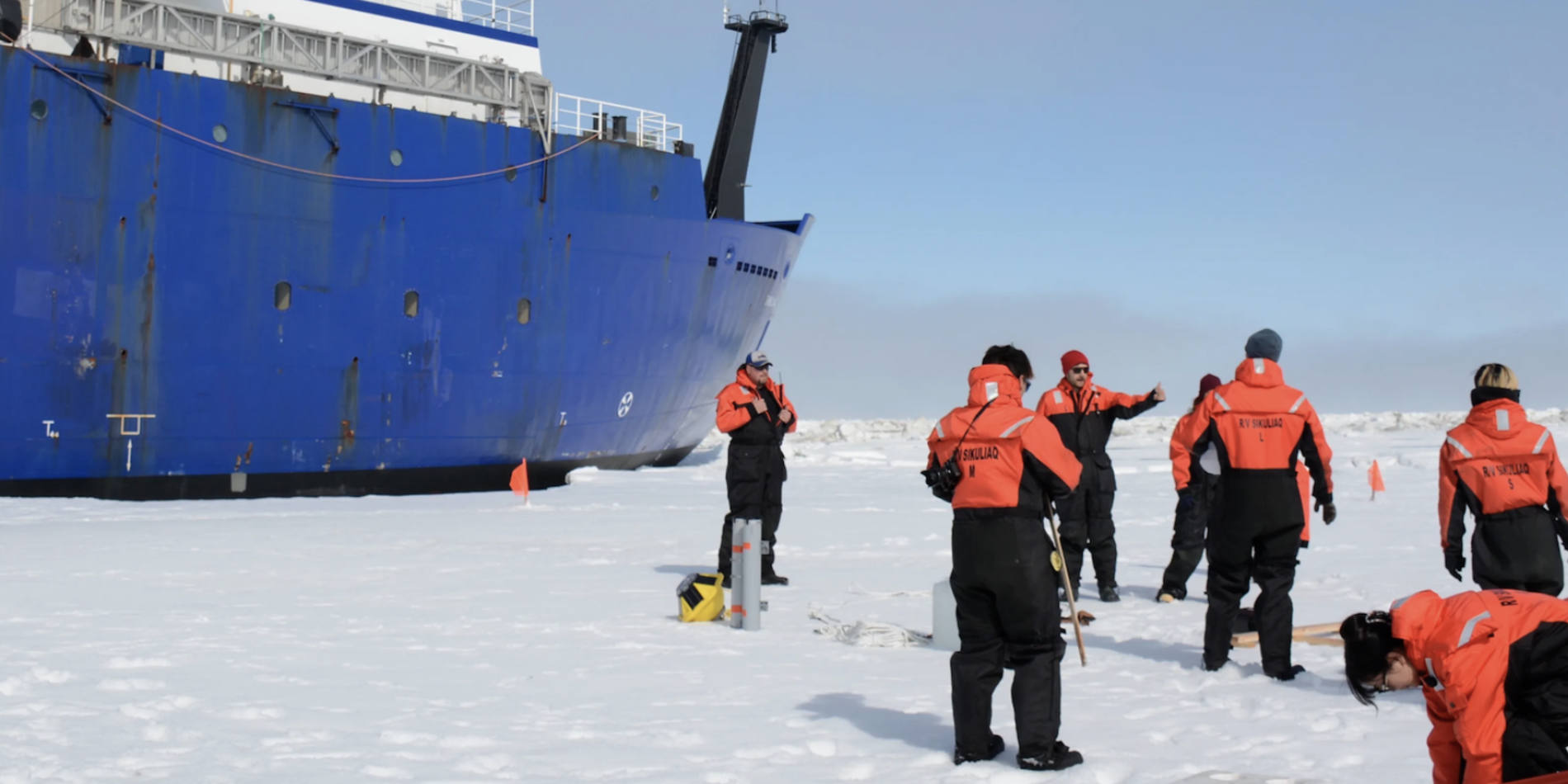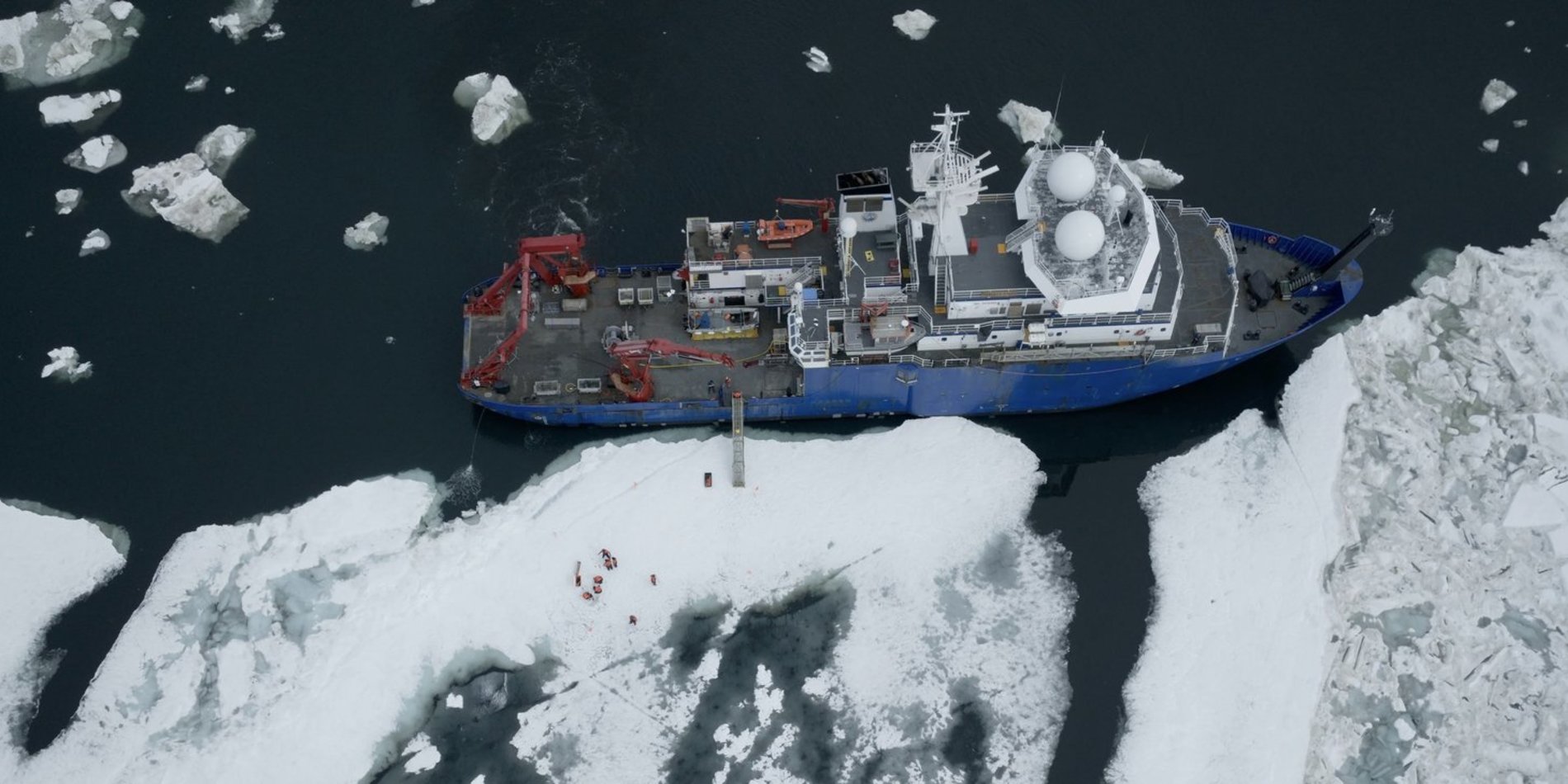Mission to understand Arctic carbon uptake and 'jewels of the sea'
Since late June, the U.S. research vessel Sikuliaq has been churning through ice in the Arctic Ocean’s shallow Chukchi Sea, carrying 20 scientists and students on a mission to learn about the future of phytoplankton at the top of the world.
No larger than a grain of sand diced into hundreds of bits, phytoplankton are plant-like organisms that remove huge amounts of carbon dioxide from Earth’s atmosphere and form the base of a marine food web topped by whales and polar bears.
“We are trying to measure the pulse of this microscopic life that supports the entire ecosystem in the Arctic, one of the most biologically productive and fastest warming places on Earth,” said biological oceanographer Kevin Arrigo, a professor in the Stanford Doerr School of Sustainability who is leading the Chukchi Sea research project in collaboration with Manu Prakash, an associate professor of bioengineering.
A future without Arctic summer sea ice
Like plants on land, phytoplankton need sunlight and nutrients to thrive. In the Arctic, which has lost about half its summer ice cover since the 1970s, the long days and open waters of late spring and early summer increasingly bring vivid swirls of blue-green phytoplankton blooms large enough to see from space.
Hidden from view, other microalgae eke out an existence within and under the floating ice. “There are communities of ice algae that bloom and turn the whole bottom of the ice green, and they begin the process for everything that grows during early spring and throughout the summer,” said Ali Palm, a student in the Stanford Doerr School of Sustainability’s Earth Systems Program who is developing an honors thesis from her work on the Sikuliaq this summer.
Today, scientists still know very little about how these three microalgae communities – in open water, within ice, and below ice – share the load of snatching carbon dioxide from the atmosphere and using it to build biomass, which either gets eaten or sinks to the bottom of the sea when phytoplankton die. The uncertainty makes it difficult to predict how an ice-free Arctic may transform the ocean’s ecosystems and ability to sequester carbon that would otherwise contribute to global warming.
At a time when the Arctic is warming four times faster than the global average, this summer’s Sikuliaq expedition could help to fill the gaps. Over the last several weeks, at more than 200 stations scattered around the Chukchi Sea during the region’s rapid summer melting season, scientists and students on the expedition have scooped up thick, silty samples from the ocean floor and trapped phytoplankton blooms 50-100 feet below floating ice floes and the surface of open water. They’ve cut cores of ice for analysis, flown drones to capture the structure of ice floes, and plunged remotely operated vehicles underwater to view algae and ice from below. Along the way, they’ve spotted scores of walruses and seals, and more than a few polar bears.
“This trip is a big opportunity. It’s a luxury and a responsibility to be in a place that is so dramatically changing,” Prakash said.
Two ocean realms
The origins of this cruise trace back more than a decade to Arrigo and colleagues’ discovery of massive phytoplankton blooms beneath ice up to 4 feet thick in the Chukchi Sea, overturning the longstanding paradigm of the Arctic Ocean in which phytoplankton were believed to proliferate almost entirely at the ice edge. “There had been hints, but really, people didn’t have a full picture of how important these under-ice blooms could be,” said Arrigo, who is the Donald and Donald M. Steel Professor at Stanford.
Building on that work, Arrigo and Kate Lewis, PhD ’18, analyzed satellite imagery and Chukchi Sea water samples to reveal in 2020 that phytoplankton growth in the Arctic Ocean had increased nearly 60% over 20 years. “The phytoplankton are making all this food that’s now available for the ecosystem,” Arrigo explained. “We want to know who is taking advantage of it.”
For example, zooplankton and the fish, seals, and bowhead whales that eat them near the ocean surface might benefit from phytoplankton drifting around the upper layers of the water column. Gray whales and walruses, which graze on phytoplankton-eating creatures near the seabed, might gain more from phytoplankton in the bottom layer known as the benthic zone.
In oceans and lakes around the world, phytoplankton generally descend to deeper waters at dawn and rise toward the surface as darkness falls. But the cues for these daily migrations remain somewhat mysterious in the Arctic, which basks in sunlight around the clock in the summer and sees barely a glimmer during winter, and historically has had enormous chunks of floating sea ice darkening waters below.
“Since most of the nutrients have been stripped out of the surface waters by summer, it would be really nice if phytoplankton could sink down to a layer where there are nutrients and then rise up to get the light. It’s been shown in some places that phytoplankton can do that, but we have no idea whether Arctic phytoplankton can,” Arrigo said.
Tracking migrations of ‘jewels of the sea’
At a seminar on the Stanford campus in 2020, Arrigo learned about an invention from the Prakash Lab that could help to answer this question and others about how the region’s ecosystems are likely to change in the future.
“It was just serendipity,” Arrigo recalled. Prakash was presenting results from a device he called a gravity machine, clearly demonstrating that the most common type of phytoplankton – single-celled algae called diatoms – can regulate their buoyancy. Often called “jewels of the sea” because of their intricate glass-like outer shells, diatoms repeatedly change their density to move through the ocean’s depths, sometimes descending 3 miles or more.
Prakash had started thinking about carbon sequestration in the ocean a few years earlier, particularly the way that it is driven by minuscule living organisms. It struck him that nearly half a century after researchers had first described the basic processes that transfer carbon from the surface to the deep ocean, scientists had yet to directly observe – at the level of individual cells or smaller – the plant and animal behavior that makes this “biological pump” work. The lack of visibility hinders mathematical models used to predict how much carbon dioxide the world’s oceans will absorb in the future.
“The dream was, what if we could observe literally a single cell traversing the ocean vertically for kilometers? We came up with a bizarre way of tackling this problem, which became what is now called the gravity machine,” said Prakash, who is a senior fellow at Stanford Woods Institute for the Environment.
The machine is a rotating microscope that provides an aquatic treadmill for diatoms or any other free-floating cells. It can electronically measure the position of a cell, and then move in a manner that keeps the cell in the same frame of reference. “I can pick a cell right out of the ocean, and whatever environmental parameters are there, we can recreate them on a tabletop on a ship at sea,” Prakash said.
This contrasts with more traditional research methods in which scientists collect field samples and then observe their behavior in a sterile and stagnant artificial environment. “Often enough, people will bring a whole bunch of cells into a lab and then say, ‘oh, this is what the cells do.’ But they’ve been stripped of their environmental and ecological context,” he said.
This summer’s Sikuliaq expedition is the first outing for the latest iteration of the gravity machine, called Gravity Machine X. In addition to rendering images of the cells in higher resolution, the microscope has been modified to handle temperatures below zero degrees Celsius.
The team has been continuously sampling the ice cores in the water column and in sediment, and building a first-of-its-kind map of the dynamic state of diatoms at sea. “We actually look at phytoplankton’s response to salinity, temperature, and light gradients and things like nutrients. When they hit a patch of high nutrient concentrations, do they slow down? Nobody has any idea,” Arrigo said.
Eventually, Prakash envisions gravity machines being so tuned to the environment that one day scientists will be able to type in GPS coordinates to simulate all of the environmental conditions for any nook of the ocean in a lab. Prakash said, “We’re not there yet, so we need to be at sea.”

Dispatches from the Arctic
Find photos and blog posts about the research team’s experiences studying phytoplankton in the Chukchi Sea at Stories from the Sikuliaq, a blog maintained by Sikuliaq crew member Natalie Cross, MS ’23, Earth Systems.
This research is supported by the National Science Foundation.
Arrigo is also a professor in the Department of Earth System Science, a senior fellow at Stanford Woods Institute for the Environment, and a member of Stanford Bio-X. Prakash is also an associate professor, by courtesy, of oceans in the Stanford Doerr School of Sustainability and of biology in the School of Humanities and Sciences. He is a member of Stanford Bio-X, Wu Tsai Human Performance Alliance, the Maternal & Child Health Research Institute, and the Wu Tsai Neurosciences Institute.



